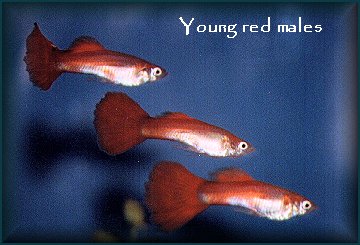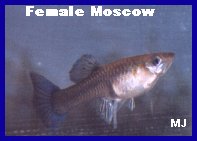The guppy is named after the Rev. J.L. Guppy of Trinidad, an early collector of the species from the late 1800's. Guppies (Poecilia reticulata) are placed in the family as mollies and mosquitofish.
Natural habitat
The wild, original guppy is native to Central America, as well as Trinidad and northern South America. Today, many guppies are found in Asia, especially Singapore, where many fancy strains are bred in large fish farms, and shipped to pet stores all over the world.
The Fancy Guppy
Fancy guppies are the result of specialized breeding techniques and they only slightly resemble the small, wild guppy, often seen in pet stores labeled "feeder fish". Credit is due these active little fish, however, which are a joy for many who keep them.
A man name Dr. Ab in the mid-sixties observed that ordinary wild guppies, when given top quality food, water, and care, gained much size. An American named Paul Hahnel used controlled breeding and selection to bring about the first true fancy-tailed guppy, similar to the veil tail of today. Other breeders worked on the colour and developed more tail shapes such as the sword tails, round tails, and spear tails. Guppy fancier groups were established, and these organizations developed a set of guppy standards by which to judge them in guppy shows.
 As a result,
emphasis was placed on large finnage, intense and uniform colour,
and keeping each strain (colour) breeding true and as
similar as possible. There are hundreds of fancy strains, and the genetic
possibilities in the guppy seem endless as more strains are
constantly being developed.
As a result,
emphasis was placed on large finnage, intense and uniform colour,
and keeping each strain (colour) breeding true and as
similar as possible. There are hundreds of fancy strains, and the genetic
possibilities in the guppy seem endless as more strains are
constantly being developed.
If the different strains are allowed to mix continually, the outcome would resemble the original wild guppy. While some genes are erased or replaced through breeding, the resulting guppy would loose much colour and size.
Notes
An ideal temperature for adult guppies is 72 to 76 F. Fry are often raised in warmer water for the first 2 or 3 months (78 - 80 F).
The guppy is a live bearer, with an average gestation period of 28 days.
The female guppy has drops of between 2-200 fry, normally about 30 to 60.
The female matures at about 3 months, the males earlier, at around 6 weeks. This depends on genetics and environment.
The life span for a well cared-for guppy is 1.5 to 3 years on average.
Temperature

An ideal temperature for adult guppies is 72 to 76 F. Fry are often raised in warmer water for the first 2 or 3 months (78 - 80 F). However, guppies can survive temperatures as low as 60°F and as high as 90°F. The higher the temperature in which a guppy lives, the shorter it's life span will be. For the first part of their lives, guppies will grow faster in higher temperatures (if sufficient food is given) so it is helpful to keep fry warm.
The guppy does well in medium-hard water. They prefer an alkaline pH (pH is the measurement of acidity/alkalinity in a specific body of water) which can be quite high (8.0 or higher) as long as the guppy is acclimatized carefully and does not experience pH swings. If you decided to mix guppies with other species of fish in a community tank, be very careful choosing tank mates. Fancy guppies are more fragile than most and will not survive with aggressive or fin-nipping fish. See the bottom of the FAQ page for more help.
Interestingly, while guppies live well without salt, they are also considered by many to be brackish (meaning they can live in a combination of fresh and sea water), and, as a matter of fact, it is possible for guppies to live in salt water with proper conditioning.